Sports and Children: Importance of Play for Cognitive, Social, Physical and Emotional Wellbeing
VerifiedAdded on 2023/06/12
|6
|1513
|443
AI Summary
This article discusses the importance of sports and play for children's cognitive, social, physical and emotional wellbeing. It highlights how playing helps children to build confidence, develop skills, learn teamwork, and bond with parents. The article also emphasizes the role of parents in guiding c...
Read More
Contribute Materials
Your contribution can guide someone’s learning journey. Share your
documents today.

Running head: SPORTS AND CHILDREN
SPORTS AND CHILDREN
Name of the student:
Name of University:
Author Note:
SPORTS AND CHILDREN
Name of the student:
Name of University:
Author Note:
Secure Best Marks with AI Grader
Need help grading? Try our AI Grader for instant feedback on your assignments.
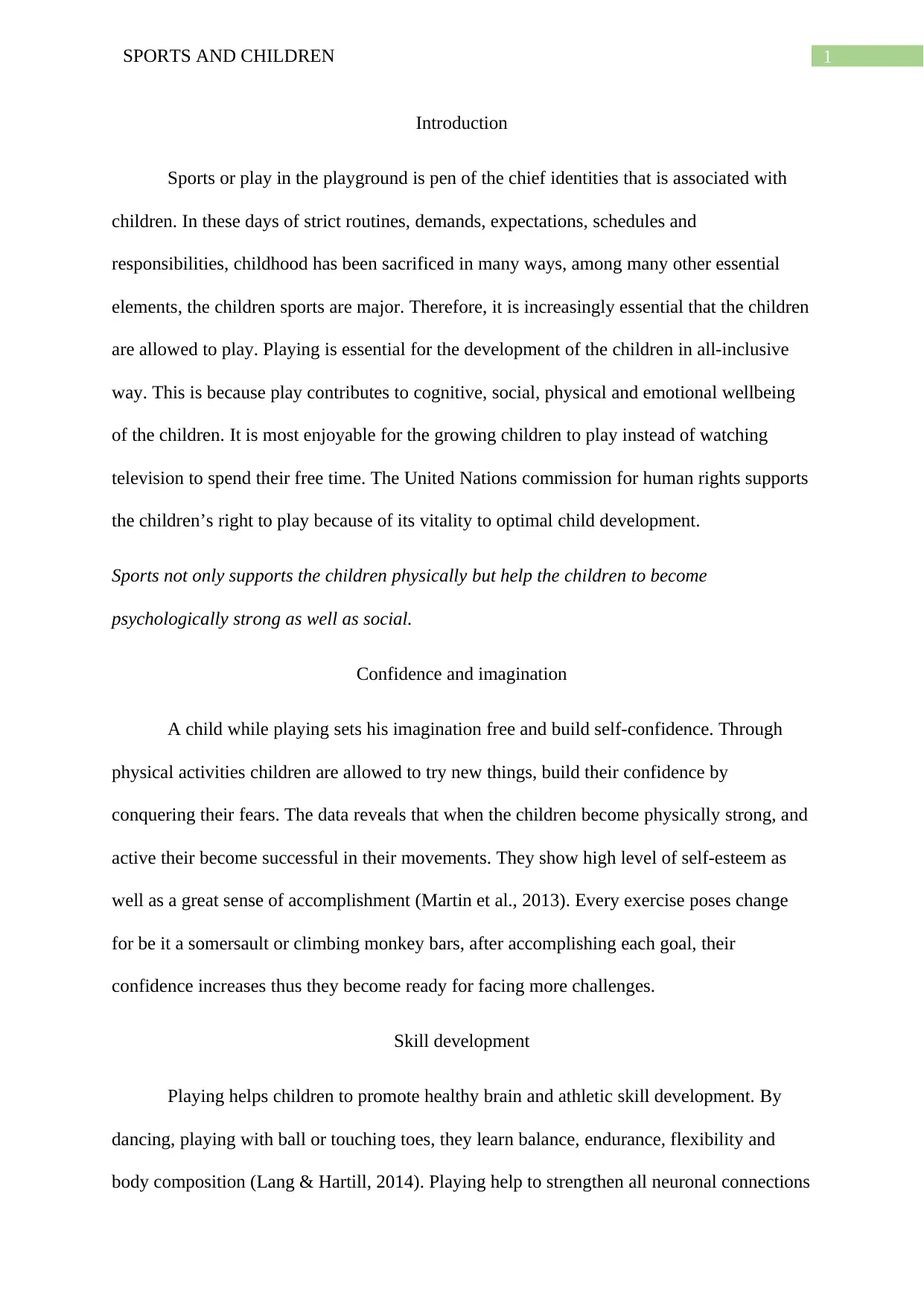
1SPORTS AND CHILDREN
Introduction
Sports or play in the playground is pen of the chief identities that is associated with
children. In these days of strict routines, demands, expectations, schedules and
responsibilities, childhood has been sacrificed in many ways, among many other essential
elements, the children sports are major. Therefore, it is increasingly essential that the children
are allowed to play. Playing is essential for the development of the children in all-inclusive
way. This is because play contributes to cognitive, social, physical and emotional wellbeing
of the children. It is most enjoyable for the growing children to play instead of watching
television to spend their free time. The United Nations commission for human rights supports
the children’s right to play because of its vitality to optimal child development.
Sports not only supports the children physically but help the children to become
psychologically strong as well as social.
Confidence and imagination
A child while playing sets his imagination free and build self-confidence. Through
physical activities children are allowed to try new things, build their confidence by
conquering their fears. The data reveals that when the children become physically strong, and
active their become successful in their movements. They show high level of self-esteem as
well as a great sense of accomplishment (Martin et al., 2013). Every exercise poses change
for be it a somersault or climbing monkey bars, after accomplishing each goal, their
confidence increases thus they become ready for facing more challenges.
Skill development
Playing helps children to promote healthy brain and athletic skill development. By
dancing, playing with ball or touching toes, they learn balance, endurance, flexibility and
body composition (Lang & Hartill, 2014). Playing help to strengthen all neuronal connections
Introduction
Sports or play in the playground is pen of the chief identities that is associated with
children. In these days of strict routines, demands, expectations, schedules and
responsibilities, childhood has been sacrificed in many ways, among many other essential
elements, the children sports are major. Therefore, it is increasingly essential that the children
are allowed to play. Playing is essential for the development of the children in all-inclusive
way. This is because play contributes to cognitive, social, physical and emotional wellbeing
of the children. It is most enjoyable for the growing children to play instead of watching
television to spend their free time. The United Nations commission for human rights supports
the children’s right to play because of its vitality to optimal child development.
Sports not only supports the children physically but help the children to become
psychologically strong as well as social.
Confidence and imagination
A child while playing sets his imagination free and build self-confidence. Through
physical activities children are allowed to try new things, build their confidence by
conquering their fears. The data reveals that when the children become physically strong, and
active their become successful in their movements. They show high level of self-esteem as
well as a great sense of accomplishment (Martin et al., 2013). Every exercise poses change
for be it a somersault or climbing monkey bars, after accomplishing each goal, their
confidence increases thus they become ready for facing more challenges.
Skill development
Playing helps children to promote healthy brain and athletic skill development. By
dancing, playing with ball or touching toes, they learn balance, endurance, flexibility and
body composition (Lang & Hartill, 2014). Playing help to strengthen all neuronal connections
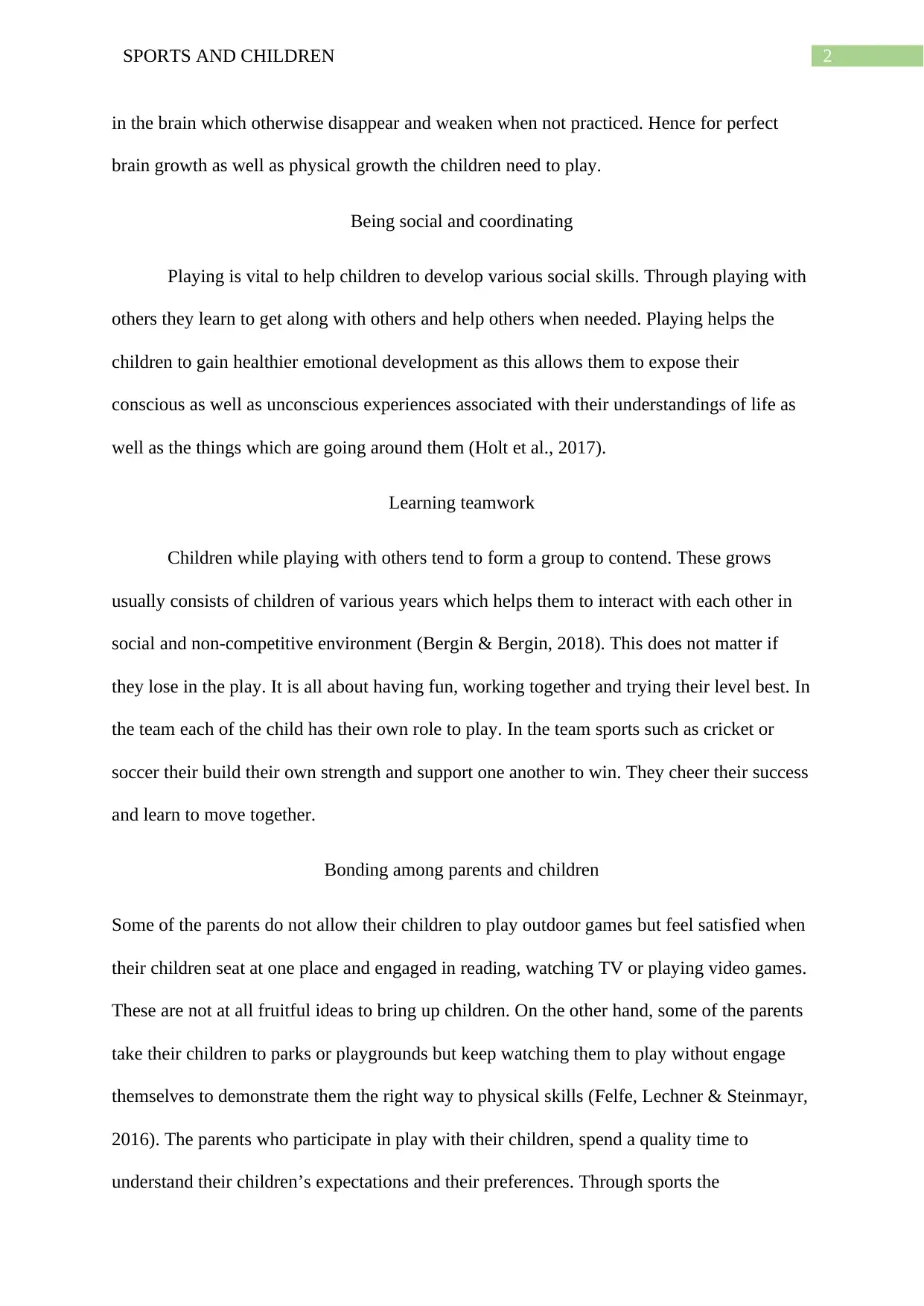
2SPORTS AND CHILDREN
in the brain which otherwise disappear and weaken when not practiced. Hence for perfect
brain growth as well as physical growth the children need to play.
Being social and coordinating
Playing is vital to help children to develop various social skills. Through playing with
others they learn to get along with others and help others when needed. Playing helps the
children to gain healthier emotional development as this allows them to expose their
conscious as well as unconscious experiences associated with their understandings of life as
well as the things which are going around them (Holt et al., 2017).
Learning teamwork
Children while playing with others tend to form a group to contend. These grows
usually consists of children of various years which helps them to interact with each other in
social and non-competitive environment (Bergin & Bergin, 2018). This does not matter if
they lose in the play. It is all about having fun, working together and trying their level best. In
the team each of the child has their own role to play. In the team sports such as cricket or
soccer their build their own strength and support one another to win. They cheer their success
and learn to move together.
Bonding among parents and children
Some of the parents do not allow their children to play outdoor games but feel satisfied when
their children seat at one place and engaged in reading, watching TV or playing video games.
These are not at all fruitful ideas to bring up children. On the other hand, some of the parents
take their children to parks or playgrounds but keep watching them to play without engage
themselves to demonstrate them the right way to physical skills (Felfe, Lechner & Steinmayr,
2016). The parents who participate in play with their children, spend a quality time to
understand their children’s expectations and their preferences. Through sports the
in the brain which otherwise disappear and weaken when not practiced. Hence for perfect
brain growth as well as physical growth the children need to play.
Being social and coordinating
Playing is vital to help children to develop various social skills. Through playing with
others they learn to get along with others and help others when needed. Playing helps the
children to gain healthier emotional development as this allows them to expose their
conscious as well as unconscious experiences associated with their understandings of life as
well as the things which are going around them (Holt et al., 2017).
Learning teamwork
Children while playing with others tend to form a group to contend. These grows
usually consists of children of various years which helps them to interact with each other in
social and non-competitive environment (Bergin & Bergin, 2018). This does not matter if
they lose in the play. It is all about having fun, working together and trying their level best. In
the team each of the child has their own role to play. In the team sports such as cricket or
soccer their build their own strength and support one another to win. They cheer their success
and learn to move together.
Bonding among parents and children
Some of the parents do not allow their children to play outdoor games but feel satisfied when
their children seat at one place and engaged in reading, watching TV or playing video games.
These are not at all fruitful ideas to bring up children. On the other hand, some of the parents
take their children to parks or playgrounds but keep watching them to play without engage
themselves to demonstrate them the right way to physical skills (Felfe, Lechner & Steinmayr,
2016). The parents who participate in play with their children, spend a quality time to
understand their children’s expectations and their preferences. Through sports the
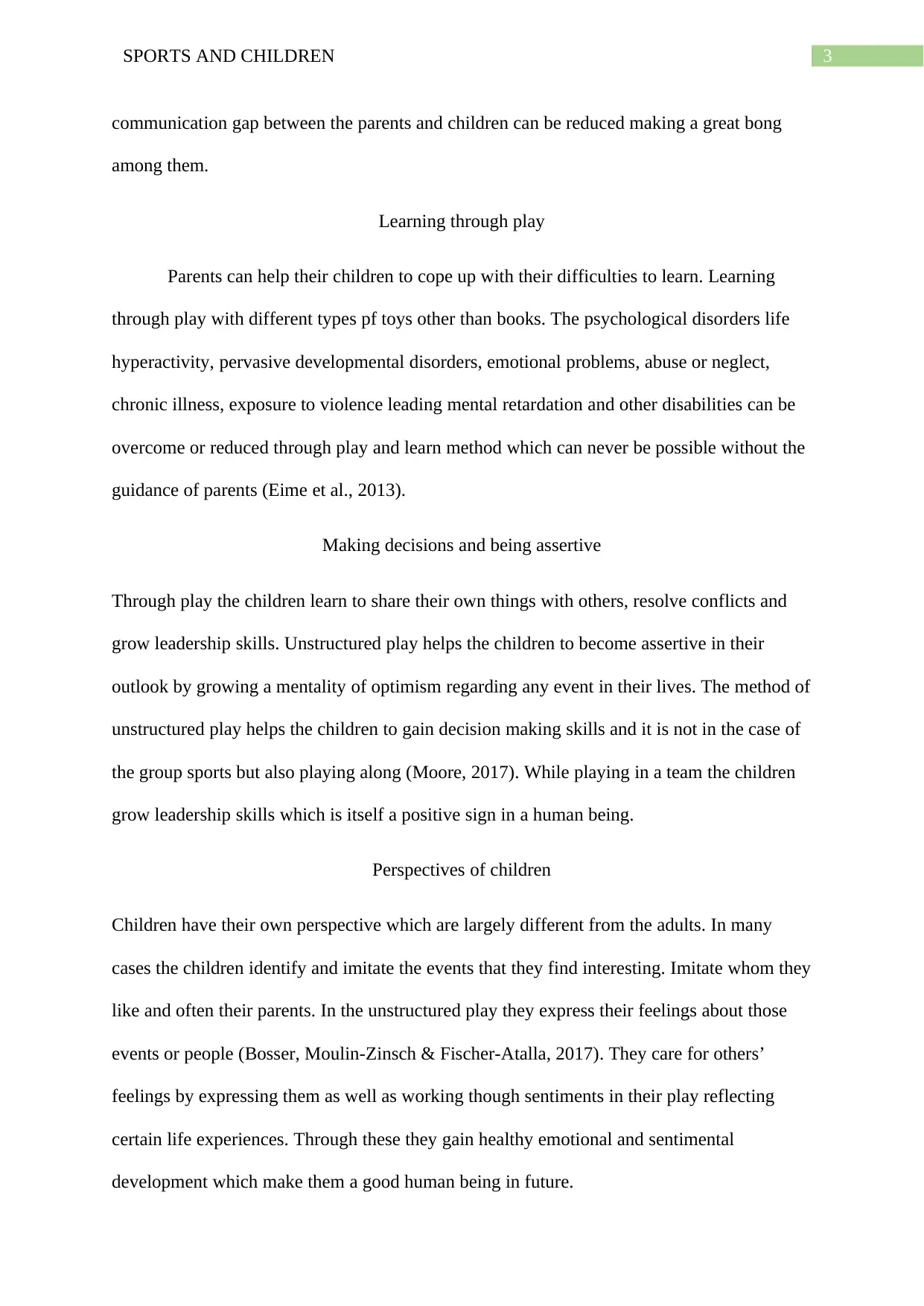
3SPORTS AND CHILDREN
communication gap between the parents and children can be reduced making a great bong
among them.
Learning through play
Parents can help their children to cope up with their difficulties to learn. Learning
through play with different types pf toys other than books. The psychological disorders life
hyperactivity, pervasive developmental disorders, emotional problems, abuse or neglect,
chronic illness, exposure to violence leading mental retardation and other disabilities can be
overcome or reduced through play and learn method which can never be possible without the
guidance of parents (Eime et al., 2013).
Making decisions and being assertive
Through play the children learn to share their own things with others, resolve conflicts and
grow leadership skills. Unstructured play helps the children to become assertive in their
outlook by growing a mentality of optimism regarding any event in their lives. The method of
unstructured play helps the children to gain decision making skills and it is not in the case of
the group sports but also playing along (Moore, 2017). While playing in a team the children
grow leadership skills which is itself a positive sign in a human being.
Perspectives of children
Children have their own perspective which are largely different from the adults. In many
cases the children identify and imitate the events that they find interesting. Imitate whom they
like and often their parents. In the unstructured play they express their feelings about those
events or people (Bosser, Moulin-Zinsch & Fischer-Atalla, 2017). They care for others’
feelings by expressing them as well as working though sentiments in their play reflecting
certain life experiences. Through these they gain healthy emotional and sentimental
development which make them a good human being in future.
communication gap between the parents and children can be reduced making a great bong
among them.
Learning through play
Parents can help their children to cope up with their difficulties to learn. Learning
through play with different types pf toys other than books. The psychological disorders life
hyperactivity, pervasive developmental disorders, emotional problems, abuse or neglect,
chronic illness, exposure to violence leading mental retardation and other disabilities can be
overcome or reduced through play and learn method which can never be possible without the
guidance of parents (Eime et al., 2013).
Making decisions and being assertive
Through play the children learn to share their own things with others, resolve conflicts and
grow leadership skills. Unstructured play helps the children to become assertive in their
outlook by growing a mentality of optimism regarding any event in their lives. The method of
unstructured play helps the children to gain decision making skills and it is not in the case of
the group sports but also playing along (Moore, 2017). While playing in a team the children
grow leadership skills which is itself a positive sign in a human being.
Perspectives of children
Children have their own perspective which are largely different from the adults. In many
cases the children identify and imitate the events that they find interesting. Imitate whom they
like and often their parents. In the unstructured play they express their feelings about those
events or people (Bosser, Moulin-Zinsch & Fischer-Atalla, 2017). They care for others’
feelings by expressing them as well as working though sentiments in their play reflecting
certain life experiences. Through these they gain healthy emotional and sentimental
development which make them a good human being in future.
Secure Best Marks with AI Grader
Need help grading? Try our AI Grader for instant feedback on your assignments.
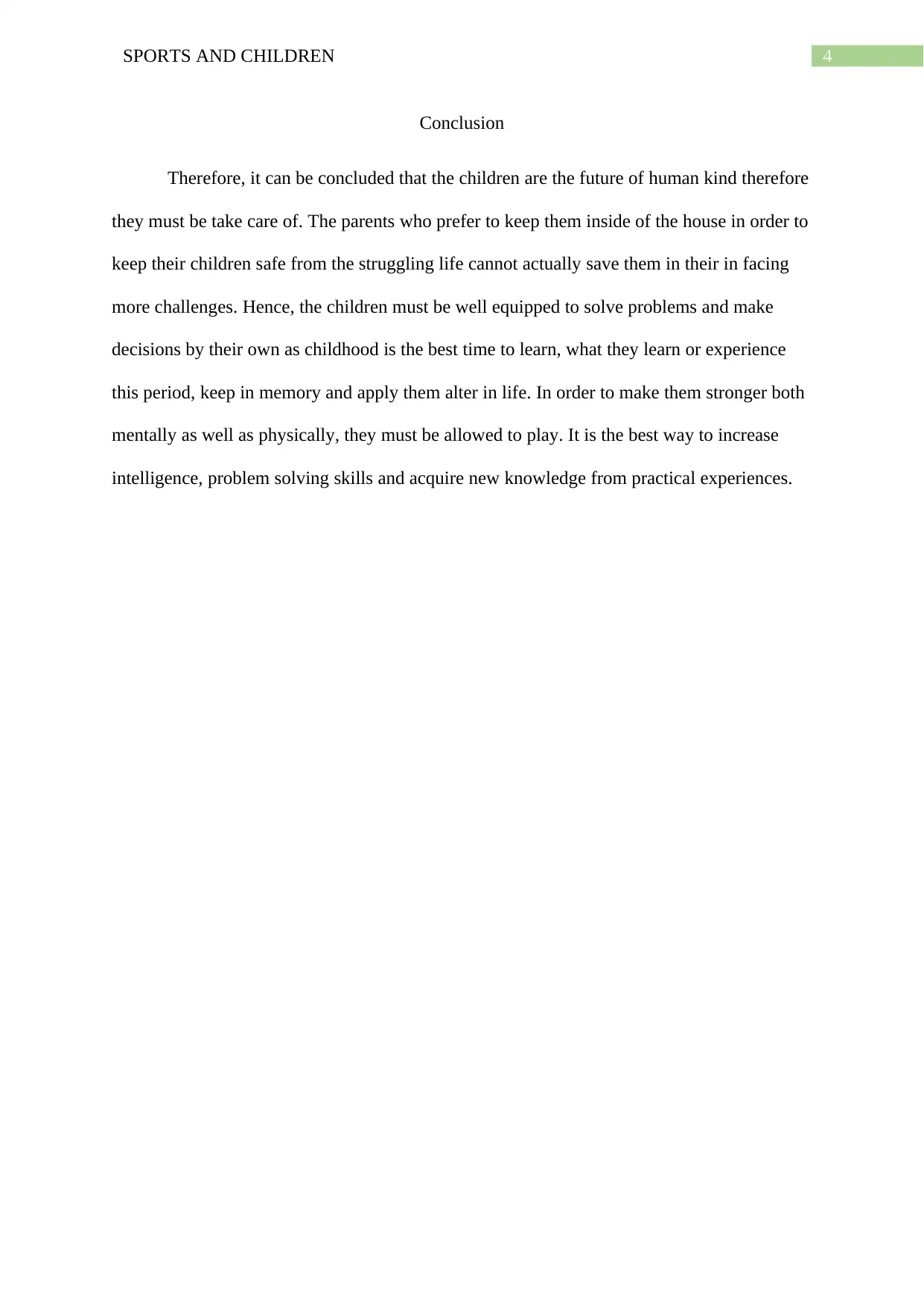
4SPORTS AND CHILDREN
Conclusion
Therefore, it can be concluded that the children are the future of human kind therefore
they must be take care of. The parents who prefer to keep them inside of the house in order to
keep their children safe from the struggling life cannot actually save them in their in facing
more challenges. Hence, the children must be well equipped to solve problems and make
decisions by their own as childhood is the best time to learn, what they learn or experience
this period, keep in memory and apply them alter in life. In order to make them stronger both
mentally as well as physically, they must be allowed to play. It is the best way to increase
intelligence, problem solving skills and acquire new knowledge from practical experiences.
Conclusion
Therefore, it can be concluded that the children are the future of human kind therefore
they must be take care of. The parents who prefer to keep them inside of the house in order to
keep their children safe from the struggling life cannot actually save them in their in facing
more challenges. Hence, the children must be well equipped to solve problems and make
decisions by their own as childhood is the best time to learn, what they learn or experience
this period, keep in memory and apply them alter in life. In order to make them stronger both
mentally as well as physically, they must be allowed to play. It is the best way to increase
intelligence, problem solving skills and acquire new knowledge from practical experiences.
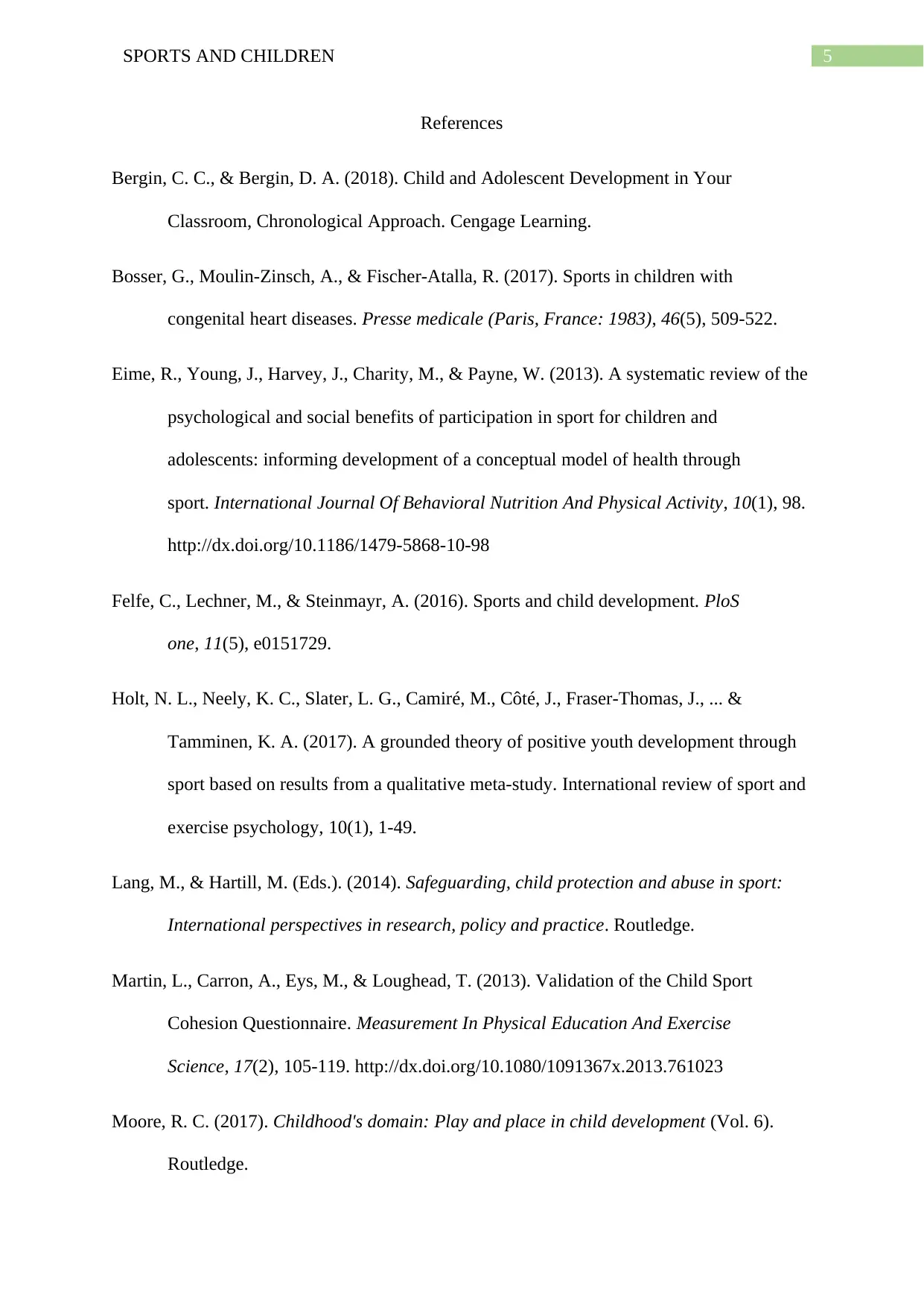
5SPORTS AND CHILDREN
References
Bergin, C. C., & Bergin, D. A. (2018). Child and Adolescent Development in Your
Classroom, Chronological Approach. Cengage Learning.
Bosser, G., Moulin-Zinsch, A., & Fischer-Atalla, R. (2017). Sports in children with
congenital heart diseases. Presse medicale (Paris, France: 1983), 46(5), 509-522.
Eime, R., Young, J., Harvey, J., Charity, M., & Payne, W. (2013). A systematic review of the
psychological and social benefits of participation in sport for children and
adolescents: informing development of a conceptual model of health through
sport. International Journal Of Behavioral Nutrition And Physical Activity, 10(1), 98.
http://dx.doi.org/10.1186/1479-5868-10-98
Felfe, C., Lechner, M., & Steinmayr, A. (2016). Sports and child development. PloS
one, 11(5), e0151729.
Holt, N. L., Neely, K. C., Slater, L. G., Camiré, M., Côté, J., Fraser-Thomas, J., ... &
Tamminen, K. A. (2017). A grounded theory of positive youth development through
sport based on results from a qualitative meta-study. International review of sport and
exercise psychology, 10(1), 1-49.
Lang, M., & Hartill, M. (Eds.). (2014). Safeguarding, child protection and abuse in sport:
International perspectives in research, policy and practice. Routledge.
Martin, L., Carron, A., Eys, M., & Loughead, T. (2013). Validation of the Child Sport
Cohesion Questionnaire. Measurement In Physical Education And Exercise
Science, 17(2), 105-119. http://dx.doi.org/10.1080/1091367x.2013.761023
Moore, R. C. (2017). Childhood's domain: Play and place in child development (Vol. 6).
Routledge.
References
Bergin, C. C., & Bergin, D. A. (2018). Child and Adolescent Development in Your
Classroom, Chronological Approach. Cengage Learning.
Bosser, G., Moulin-Zinsch, A., & Fischer-Atalla, R. (2017). Sports in children with
congenital heart diseases. Presse medicale (Paris, France: 1983), 46(5), 509-522.
Eime, R., Young, J., Harvey, J., Charity, M., & Payne, W. (2013). A systematic review of the
psychological and social benefits of participation in sport for children and
adolescents: informing development of a conceptual model of health through
sport. International Journal Of Behavioral Nutrition And Physical Activity, 10(1), 98.
http://dx.doi.org/10.1186/1479-5868-10-98
Felfe, C., Lechner, M., & Steinmayr, A. (2016). Sports and child development. PloS
one, 11(5), e0151729.
Holt, N. L., Neely, K. C., Slater, L. G., Camiré, M., Côté, J., Fraser-Thomas, J., ... &
Tamminen, K. A. (2017). A grounded theory of positive youth development through
sport based on results from a qualitative meta-study. International review of sport and
exercise psychology, 10(1), 1-49.
Lang, M., & Hartill, M. (Eds.). (2014). Safeguarding, child protection and abuse in sport:
International perspectives in research, policy and practice. Routledge.
Martin, L., Carron, A., Eys, M., & Loughead, T. (2013). Validation of the Child Sport
Cohesion Questionnaire. Measurement In Physical Education And Exercise
Science, 17(2), 105-119. http://dx.doi.org/10.1080/1091367x.2013.761023
Moore, R. C. (2017). Childhood's domain: Play and place in child development (Vol. 6).
Routledge.
1 out of 6
Related Documents
Your All-in-One AI-Powered Toolkit for Academic Success.
+13062052269
info@desklib.com
Available 24*7 on WhatsApp / Email
![[object Object]](/_next/static/media/star-bottom.7253800d.svg)
Unlock your academic potential
© 2024 | Zucol Services PVT LTD | All rights reserved.





